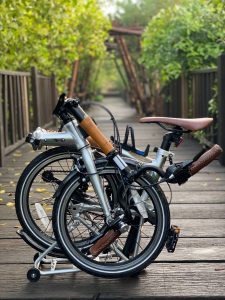Best Bike Helmet Lights in 2023 For Greater Visibility
- Michael
- Last Updated August 13, 2023
We are a reader supported site. We earn commissions when you buy through links on our site. Learn more.
If you’re in a hurry and want to know what the best bike helmet light is, then we recommend the Light & Motion Vis Pro 1000 Trail to be the best one.
If you’d like to purchase a new helmet light for your bike and have been torn between the many options available, this guide is for you.
We’ll shed light on some of the best bike helmet lights on the market today. We’ll also shed light on what to look for when choosing a bike helmet light, so stick around.
My Picks for the Best Bike Helmet Lights in 2023
- Light & Motion Vis Pro 1000 Trail
- Brightside Bike Helmet Light
- Greerride Bike Helmet Light
- BLITZU Gator Bike Light Set
- WASAGA Bike Helmet Light
- Ascher Ultra Bright USB Rechargeable Bike Light Set
The 6 Best Bike Helmet Lights Today
Bike helmet lights have become a necessary safety accessory for those of us who prefer to ride at night or early in the morning.
Check out these top picks based on hours of research and testing!
Light & Motion Vis Pro 1000 Trail

The Vis Pro 1000 Trail from Light & Motion delivers some serious features for its relatively high price. It’s not the most budget-friendly option on the market, but it’s definitely worth every penny.
As the name suggests, this helmet light boasts a 1000-lumen white light at the front and two red sidelights for extra safety at intersections.
It has a setting called ‘SafetyPulse’ where the light blinks at intervals for daytime visibility. It’s also rated IP67 (check out this file for IP rating chart) for dust and waterproof quality, making it ideal for rainy day rides.
Vis Pro 1000 Trail has four modes and houses a fast-charging battery that offers up to 12 hours of continuous use. Besides being a bike helmet light, the Vis Pro 1000 comes with a handlebar mount and is compatible with the GoPro interface.
Note that the Vis Pro 1000 Trail is part of a line of bike lights from Light & Motion with different price points that can also be used as helmet lights.
However, it’s the only one that comes with helmet mounting gear. That said, if you wish to buy a cheaper option, you’ll have to get the mounting straps separately.
Pros:
- Powerful 1000 lumen front light
- Two red sidelights for intersection safety
- Battery power can be extended using an external battery pack
- Fast charging via a USB cable
- IP67 rating
- Can be mounted on the handlebar as a powerful bike headlight
- 2-year warranty
Cons:
- Higher price point than other models
- No backlight option
- The battery can’t be replaced
Brightside Bike Helmet Light

The Brightside Bike Helmet Light is a lightweight, compact option for riders who don’t want to weigh down their helmets.
This 100-lumen helmet light comes with both a front white light and rear red light for optimal visibility on the road.
The Brightside is USB-rechargeable and has a 43-hour runtime on a single charge. With seven modes to choose from, you can easily toggle the Brightside to your liking.
One of its best features is its wide-angle light—rather than a focused beam. This improves your visibility so drivers can see you from all directions. Plus, you can choose between front and rear lights to blink simultaneously or in turns.
However, it has a short-range. This means you’ll still need a handlebar headlight while using the Brightside.
Pros:
- Has both front and rear lights
- Lightweight and easily mounted
- Seven different constant and flashing modes
- The wide light angle increases visibility
- Runs up to 43 hours on a single charge
- Waterproof
Cons:
- Short-range light; has to be used with a brighter headlight
- Mounts are relatively weak and need support in harsh conditions
Greerride Bike Helmet Light

This Greerride Bike Helmet Light is another excellent option for daytime visibility. It features a brightness of 100 lumens with both front and rear lights that can either blink or work continuously.
The Greerride is very lightweight at just 2 ounces and is also USB-rechargeable. Best of all, it comes with an adjustable helmet strap and a handlebar strap if you’d like to use it as an assisting headlight.
This is a no-frills option that helps you stay visible to drivers without much fuss. It has an IPX6 waterproof rating and a sturdy aluminium casing.
Pros:
- Lightweight and compact construction
- Adequate brightness
- USB fast charging at just 2 hours
- Constant and flashing modes for both front and rear lights
Cons:
- Mounting straps can break in use, so it’s best to support it with zip ties or velcro
- Can’t be used alone without a focused, bright headlight
BLITZU Gator Bike Light Set

The BLITZU Gator boasts 450 lumens of brightness and is one of the more affordable options on the market.
This is a wildcard in the bike-light world, as it can be used as a headlight and a helmet light. It also comes in a set with a trusty little 120-lumen tail light.
The Gator also has a unique feature, which is the swiveling mount. It can rotate a full 360 degrees to provide visibility in all directions. It also has high, med, flash, and strobe modes.
The front light is less than 2.5 ounces to prevent your helmet from being weighed down. In addition, the taillight can be attached to the back of your seat or helmet with ease.
All in all, the BLITZU Gator seems to check a lot of boxes for riders, which makes it a pretty popular choice.
Pros:
- Budget-friendly option
- Comes in a set of 2 lights that can be mounted separately
- Swiveling mount for better all-around visibility
- Powerful 450-lumen front light
- IPX5 waterproof rating
Cons:
- Enclosed mounts are on the cheaper side; best supported with zip ties or velcro
- Has a maximum of 6 hours-per-charge working time; not ideal for long rides
WASAGA Bike Helmet Light

The WASAGA Bike Helmet Light is a good option for riders who want a dependable, sturdy helmet light. At 200 lumens, it’s brighter than some of the previous options.
It features a pair of 10w white LED front lights and red LED taillights. The front lights have three modes: high, medium, and low that can last up to 14 hours.
The taillights are available in five modes: steady, fast strobe, slow strobe, alternately strobe, and warning strobe.
This bike light is also waterproof with an IP63 rating. So it’s the perfect accessory for use during heavy rainfall.
What’s more, the company offers a money-back guarantee in case you have a problem that isn’t solved within 24 hours.
Pros:
- Great headlight brightness at 200 lumens
- Long battery life for such a lightweight design
- Waterproof rating of IP63
- Money-back guarantee
Cons:
- No flashing or strobing options for headlight
- Has to be used with a strong handlebar light
Ascher Ultra Bright USB Rechargeable Bike Light Set

The Ascher Ultra Bright Bike Light Set isn’t marketed as a helmet light set. Yet, it remains a favorite of many riders when it comes to powerful and durable bike helmet lights.
With a bright 300-lumen front light and four operating modes, this is a worthy contender. Even more impressive is its running time. The front light can last up to 12 hours, whereas the tail light can last for 16 hours.
It’s user-friendly and quickly recharges via USB. Plus, it comes with mounts for both the front and the rear lights.
If you prefer, you can purchase velcro strips or zip ties for helmet mounting separately. They just go into the helmet vents and wrap tightly around the light to secure it in place.
Pros:
- Strong 300-lumen front light that can be used without a handlebar-mounted light
- Taillight can be attached to helmet or seat
- Can run up to 12-16 hours on a single charge
- Extremely durable construction
Cons:
- Not marketed as a helmet light, so no helmet mounts come with the purchase
- Only IPX4 waterproof rating, so not ideal for use during heavy rainfall
How to Choose a Suitable Bike Helmet Light?
If you’ve read through this guide, you’re probably in the market for a bike helmet light that’s both durable and meets all your needs.
To make sure you get the most bang out of your buck, we rounded up some things to consider. Some are about the specs and features of the light, while others focus more on what your riding needs.
Here are the most important factors to take into consideration:
Placement
You can either have a front light only or both a front and a rear light on your helmet. If you ride in off-trodden paths without much traffic, a front light with a wide visibility angle is probably all you need.
However, it won’t hurt to add a blinking taillight to your seat or helmet just to avoid rear collisions of any kind.
If you ride on roads with lots of cars, it’s of paramount importance to have a blinking or strobing taillight on your bike or helmet. Those behind you should be able to see it from a distance of at least 20 feet.
These light modes alert drivers there’s someone ahead. Thus, it allows enough time to slow down in hazy or dim-lit conditions.
Whether you choose to mount this light on your handlebar or helmet, make sure it’s secure in place.
Brightness
Bike lights, not just helmet lights, come in many different brightness options. It’s advisable to have a headlight of at least 300–400 lumens for safe riding in all conditions.
Some riders prefer their helmet front light to complement their handlebar-mounted front light. It should suffice to have one with just enough lumens to see ahead if they turn right or left in pitch-black darkness. On the other hand, rear lights don’t have to be anything brighter than 200 lumens.
Keep in mind these are used for visibility so drivers on the road can see you. Therefore, it’s not in your best interest not to blind them with excessively bright lights.
Light Modes
Both constant and blinking lights play an essential role. This is why choosing a bike helmet light with both options is standard procedure.
Fortunately, almost all of the products on the market now have different modes. Some are even going to further lengths with their blinking or flashing options, signaling different things like ‘stop’ and ‘turn’.
Dust and Waterproofing
Most good-quality bike helmet lights offer a degree of waterproofing for when you need to ride in harsh weather. Look for a waterproof rating of IPX5 or higher.
Also, try to opt for a case made of aluminium, nylon, or both. This design helps seal all the parts better than regular plastic
Rechargeable Batteries
All makes and models we’ve discussed have USB rechargeable lithium batteries. They’re quick charging and can last for long hours, ensuring a safer, more reliable ride.
Always check the battery charging status before going on a ride. Then, charge the lights as soon as you get home so they’re ready for your next time.
Alternatively, you might find older models that run on AA or AAA batteries. Yet, we strongly recommend you stay away from those because there’s nothing worse than having a light dim or die in the middle of the ride.
Mounting Mechanism
As we mentioned earlier, you should always make sure your light is securely mounted on your helmet before you go on a ride.
If the light you choose has a weak mounting style, it’s more prone to breaking mid-ride. That can put you in a potentially dangerous situation.
Velcro strips and nylon zip ties are a favorite among riders. They secure the light to the helmet and are easy to remove when you want to charge the batteries.
Size
It might sound trivial, but a bike helmet light that’s too small isn’t exactly practical. For starters, it might not have a wide-enough angle that could compromise your safety.
Another reason is that it can easily get misplaced or lost.
Some people are more prone to misplacing things, so if you’re one of them, choose a light with a substantial size so it doesn’t fall easily through the cracks.
Weight
When choosing a bike helmet light, be sure to check in its specs for weight, especially if you’re shopping for a children’s helmet light. Heavy lights can be very uncomfortable and clunky. They can even lead to neck pains.
You can easily find lights that weigh less than 2 ounces and work just as well as the heavier models. That said, try to stay away from cheap ones that are super light. These might not be as durable or long-lasting.
Frequently Asked Questions
Here are some of the most frequently asked questions related to bike helmet lights:
Do I really need a bike helmet light?
The short answer is yes. For safety and practicality, a bike helmet light will help you be more visible to drivers on the road while also illuminating the direction you’re heading. Handlebar headlights are important, of course, but a bike helmet light is more versatile and practical.
If you’re torn between a handlebar-mounted light or a helmet light and don’t want to buy both, go with the latter. Choose a high-quality model with multiple modes; they’ll make your life a lot easier.
Last but not least, make sure you’re incorporating other safety measures when you’re on the road. Bike collision accidents took the lives of 961 people in 2023, so choosing the right trail, wearing protective gear, and signalling lights are literally life-saving.
Are there other ways I can add lights to my helmet?
There are other ways to add rear signaling lights to your helmet, such as electroluminescent tapes or LED tapes. Those are just strips of tiny lights that can be programmed to give out a constant light. They can also be programmed to strobe or blink and usually come with an adhesive strip in the back.
Of course, these are a cheaper option than regular helmet lights, but they won’t offer the same level of brightness or power. They barely project light a few feet ahead, which means they won’t work in hazy or pitch dark conditions.
How many lumens do I need?
It’s always good to have a powerful light, but in some situations, it can be a case of diminishing returns. Since using a very bright, blinding rear light can cause accidents, stick to 10–50 lumens for the signalling light. Also, if the bike light flashes blue, make sure it’s legal in your state.
Since the front headlights are used for navigation, choose something that best suits your needs. Here’s a rough estimate for each situation:
- Daylight = 100+ lumens
- Urban areas = 100 lumens
- Rural areas = 500 lumens
- Mountain trails and off-road biking = 1000 lumens
What are the best bike helmet light brands?
Look around for names like Light & Motion, Greerride, or Brightside when shopping. Other less-known brands like Ascher or BLITZU might be a good option as well.
How do I take care of my bike helmet lights?
Aside from charging the battery after every ride and keeping the casing clean, a helmet light is pretty low-maintenance.
Just make sure to check on the mount and ties used to attach it to the helmet. In addition, you should replace any torn or worn-out pieces to prevent any mishaps during your ride.
Conclusion
Gone are the days of taping a flashlight to your helmet and hoping it doesn’t fall off! The best bike helmet lights we highlighted in this guide set a new standard for safety and comfort.
Most of them can also be used for camping, hiking, and many other outdoor activities where you move around in the dark and have limited access to electricity for hours on end.
If you commute to work on a highway, your requirements for a bike helmet light will differ from a mountain bike or off-trail biker. As we mentioned earlier, when you go out riding also affects the light power.
Keep in mind that, in most cases, you get what you pay for. For example, a good bike helmet light will last you several years. So, it’s better to invest in a slightly better quality one instead of choosing the cheapest option that might not last as long.

Michael
Hi, my name is Michael and I'm the chief editor of this website.
I've been riding all sorts of bikes for over a decade now and don't plan on stopping anytime soon.
Everyday, I learn new things and want to share my experiences with others.
Ready to join me on my journey?






